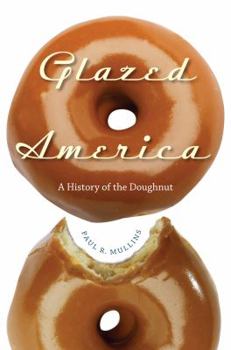Glazed America: A History of the Doughnut
Select Format
Select Condition 
Book Overview
In Mullins's skillful hands, this simple pastry provides surprisingly compelling insights into our eating habits, our identity, and modern consumer culture. This description may be from another edition of this product.
Format:Hardcover
Language:English
ISBN:0813032385
ISBN13:9780813032382
Release Date:September 2008
Publisher:University Press of Florida
Length:224 Pages
Weight:0.10 lbs.
Dimensions:0.8" x 6.3" x 9.3"
Customer Reviews
1 rating
A Beloved and Detested Sweet Treat
Published by Thriftbooks.com User , 16 years ago
"Tell me what you eat," said that philosopher of the kitchen Anthelme Brillat-Savarin, "and I will tell you what you are." What would he make of a nation which has the doughnut as one of the foods the world knows it by? What does it mean that doughnuts are defined as a particularly American food? Perhaps an anthropologist could tell us, and in the surprising and enlightening _Glazed America: A History of the Doughnut_ (University Press of Florida), anthropologist Paul R. Mullins has done so. Indeed, he has found those who say that a Krispy Kreme shop makes them proud to be Americans, and those who regard a shop as a shrine with pilgrims and converts. "It may seem absurd," Mullins writes, "that an apparently innocuous doughnut could be wrapped in the flag and lent an air of religiosity, but few dimensions of our world say as much about us as food." We do, however, have mixed feelings about our doughnuts. We may like them, but even those of us who like them know they are not really good for us, and there are those who hate them because they represent decadence or foolish food choices. Doughnuts, then, have a disputed symbolism, and their marketing and consumption can be mined, surprisingly, for various insights into American life. The book reproduces a 1627 still life painting by Juan van der Hamen y Leon which shows pastries of the torus shape anyone would now recognize. This particular shape had one of its first mentions in print in 1877. That the toroidal shape certainly pre-dates cookbooks or oil paintings did not prevent an American from claiming invention of the doughnut hole. Captain Hanson Gregory, a cook at sea, found that the soggy and greasy doughnuts he was making resisted becoming more digestible by changing their ingredients, but once he lessened the lumps of dough by cutting a hole out, changing the shape made all the difference. He was nominated to the National Doughnut Hall of Fame for his contribution; the nomination read in part that he "not only discovered the hole in the first place, but invented the proper process for enclosing the hole in the doughnut." The Doughnut Corporation of America thus in the 1940s attempted to certify the appeal of assigning the origin of the hole in the doughnut to a New England seafarer. This is the same company that produced what Mullins says is "an ideologically distorted 1944 account" which claimed that the Pilgrims themselves brought their treasured doughnut recipe with them to the New World on the _Mayflower_. In 2005, Florida governor Jeb Bush tried to strike a blow for Republicans within blue collar workers, when he wanted to know how many tax cuts Democrats had proposed for "Joe Bag of Donuts." In this, he was able to avoid reference to the drinking habits of Joe Six Pack, but Mullins shows that the consumption of doughnuts transcends economic class. However, the great spokesman for the doughnut is that industrial worker Homer Simpson, who gets four pages of coverage here





